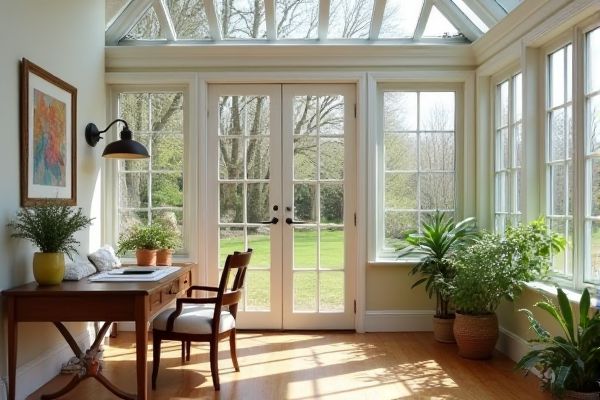
Choosing between a sunroom desk and a standing desk depends on whether you prioritize natural light and a scenic view or ergonomic benefits and movement throughout your workday. Explore this article to discover which desk option best complements Your productivity and well-being.
Table of Comparison
| Feature | Sunroom Desk | Standing Desk |
|---|---|---|
| Primary Use | Leisure and light work in sunrooms | Ergonomic workspace promoting standing |
| Material | Typically wood or rattan, weather resistant | Metal frame with wood, laminate, or adjustable surfaces |
| Adjustability | Fixed height, non-adjustable | Height adjustable, manual or electric |
| Ergonomics | Basic seating comfort, less ergonomic | Designed for posture and movement health |
| Portability | Lightweight but not designed to move frequently | Generally heavier, stationary setup preferred |
| Usage Environment | Indoor sunrooms or conservatories | Office or home workspace |
| Price Range | Budget to mid-range ($100-$400) | Mid-range to premium ($250-$1200+) |
| Health Benefits | Limited | Improves circulation, reduces sitting time |
Introduction to Sunroom Desks and Standing Desks
Sunroom desks offer a stylish and compact workspace solution ideal for natural lighting and small spaces, enhancing productivity with an inviting atmosphere. Standing desks promote ergonomic health by encouraging movement and reducing the negative effects of prolonged sitting, supporting better posture and increased energy levels. Both desk types cater to different needs: sunroom desks prioritize aesthetic integration and space efficiency, while standing desks focus on physical well-being and flexibility.
Key Differences Between Sunroom and Standing Desks
Sunroom desks are typically designed to blend with natural light and outdoor views, offering a relaxed workspace often integrated into sunroom settings, whereas standing desks prioritize ergonomics and adjustable height features to promote movement and reduce sedentary posture. Unlike standing desks, sunroom desks may lack height adjustability but provide an aesthetic appeal that enhances your connection with nature. Choosing between the two depends on whether your focus is on ergonomic health benefits or creating a bright, enjoyable work environment.
Ergonomic Benefits: Sunroom Desk vs Standing Desk
Sunroom desks offer ergonomic benefits by providing a comfortable, natural light-filled environment that can reduce eye strain and improve mood, enhancing productivity during seated work. Standing desks promote better posture by reducing prolonged sitting, which can decrease back pain and increase energy levels through regular movement. Balancing your use of a sunroom desk and standing desk can optimize comfort and health by combining natural light with the advantages of varied working positions.
Productivity Impact: Which Desk Enhances Focus?
Sunroom desks, bathed in natural light, create an environment that reduces eye strain and boosts mood, directly enhancing focus and productivity. Standing desks encourage movement and improve circulation, leading to increased alertness and decreased fatigue during long work sessions. Choosing between the two depends on whether natural ambiance or ergonomic benefits better support individual concentration and work habits.
Health Considerations for Each Desk Type
Sunroom desks offer a relaxing environment that encourages natural light exposure, which can improve mood and reduce eye strain but may lack ergonomic adjustability, potentially causing poor posture over time. Standing desks promote better circulation, reduce risks associated with prolonged sitting such as cardiovascular disease, and encourage movement, yet they require proper usage to avoid fatigue or joint discomfort. Choosing between the two depends on individual health goals, ergonomic needs, and the balance between comfort and active posture support.
Style and Aesthetic: Sunroom vs Standing Workspace
Sunroom desks often feature natural wood finishes and incorporate large glass windows, creating a bright, airy aesthetic that blends indoor comfort with outdoor ambiance. Standing desks showcase a modern, minimalist style with sleek metal frames and adjustable heights, emphasizing ergonomics and productivity. The contrasting designs offer either a tranquil, nature-inspired workspace or a dynamic, contemporary setup tailored to active work routines.
Space Requirements and Flexibility
Sunroom desks typically require ample space to accommodate natural light and aesthetic design features, making them ideal for spacious areas that blend indoor comfort with outdoor ambiance. Standing desks offer greater flexibility in smaller or multipurpose spaces due to adjustable height settings and compact designs, allowing users to switch between sitting and standing postures efficiently. Optimizing room layout with a standing desk enhances ergonomic benefits while maximizing usable floor space, contrasting with the more static footprint of a sunroom desk.
Cost Comparison and Budget Considerations
Sunroom desks generally offer a more affordable option compared to standing desks, often costing between $100 to $300, making them suitable for tight budgets. Standing desks can range from $250 to over $1,000 depending on features like adjustable height and motorized functions, which significantly impacts your overall investment. Your choice should balance ergonomic benefits with cost, ensuring that your workspace setup aligns with both comfort needs and financial constraints.
User Experiences: Testimonials and Case Studies
User experiences highlight that sunroom desks offer a unique blend of natural light and scenic views, enhancing mood and productivity according to multiple testimonials. Case studies reveal increased creativity and reduced stress among users who prefer sunroom desks for their calming environment. In contrast, standing desks receive praise for promoting better posture and reducing sedentary behavior, with numerous reports of improved energy levels and decreased back pain.
Choosing the Right Desk for Your Needs
Choosing the right desk depends on your work habits and space requirements. A sunroom desk offers natural light and a relaxed atmosphere ideal for creative tasks or light work, while a standing desk promotes better posture and increased energy levels during long hours of work. Assess your daily routine and ergonomic needs to determine whether the calming environment of a sunroom desk or the health benefits of a standing desk suit your productivity goals best.
 homyna.com
homyna.com